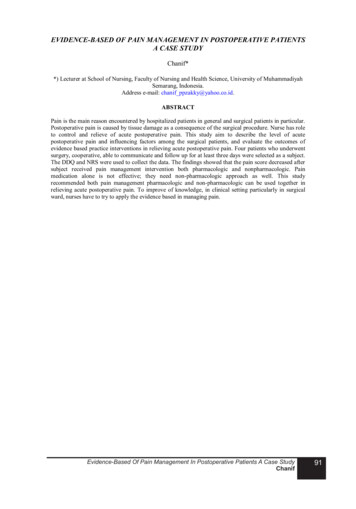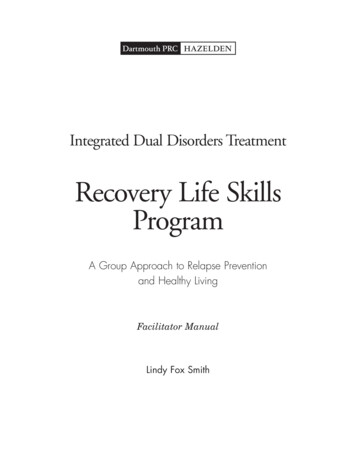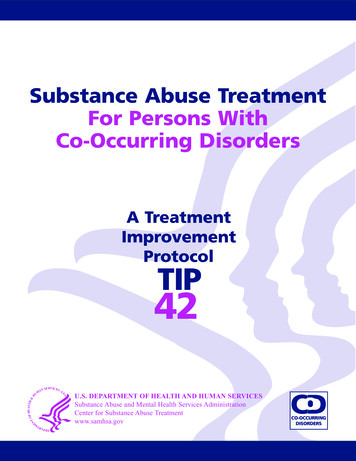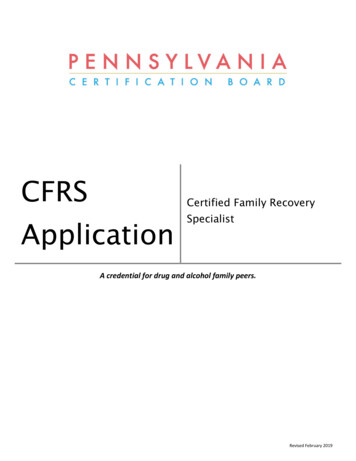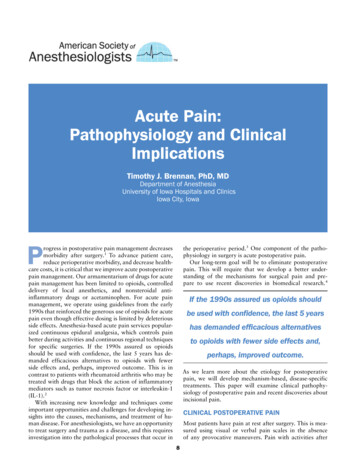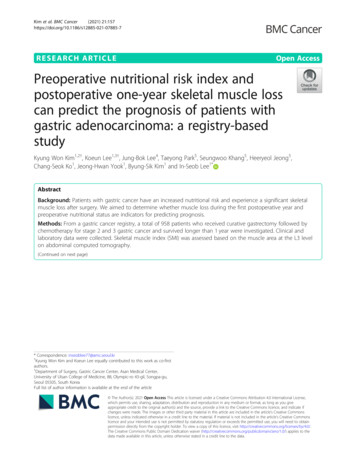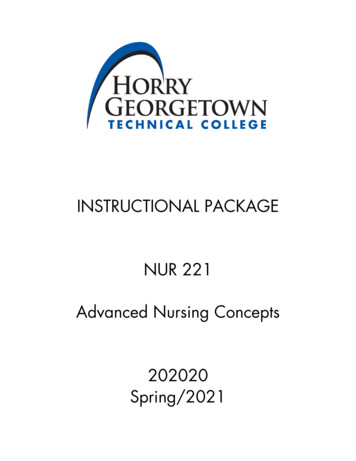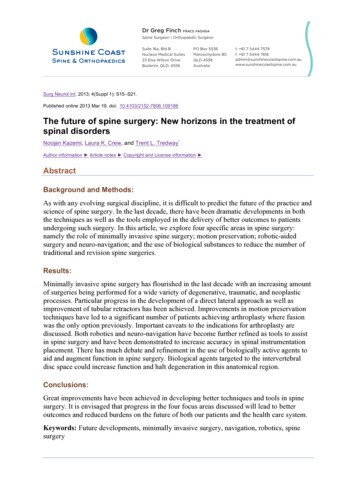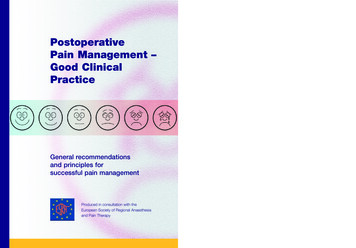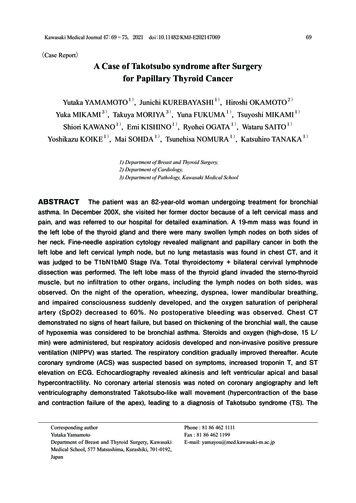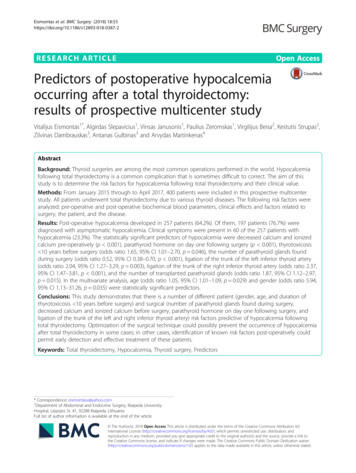
Transcription
Eismontas et al. BMC Surgery (2018) ARCH ARTICLEOpen AccessPredictors of postoperative hypocalcemiaoccurring after a total thyroidectomy:results of prospective multicenter studyVitalijus Eismontas1*, Algirdas Slepavicius1, Vinsas Janusonis1, Paulius Zeromskas1, Virgilijus Beisa2, Kestutis Strupas2,Zilvinas Dambrauskas3, Antanas Gulbinas3 and Arvydas Martinkenas4AbstractBackground: Thyroid surgeries are among the most common operations performed in the world. Hypocalcemiafollowing total thyroidectomy is a common complication that is sometimes difficult to correct. The aim of thisstudy is to determine the risk factors for hypocalcemia following total thyroidectomy and their clinical value.Methods: From January 2015 through to April 2017, 400 patients were included in this prospective multicenterstudy. All patients underwent total thyroidectomy due to various thyroid diseases. The following risk factors wereanalyzed: pre-operative and post-operative biochemical blood parameters, clinical effects and factors related tosurgery, the patient, and the disease.Results: Post-operative hypocalcemia developed in 257 patients (64.2%). Of them, 197 patients (76.7%) werediagnosed with asymptomatic hypocalcemia. Clinical symptoms were present in 60 of the 257 patients withhypocalcemia (23.3%). The statistically significant predictors of hypocalcemia were decreased calcium and ionizedcalcium pre-operatively (p 0.001), parathyroid hormone on day one following surgery (p 0.001), thyrotoxicosis 10 years before surgery (odds ratio 1.65, 95% CI 1.01–2.70, p 0.046), the number of parathyroid glands foundduring surgery (odds ratio 0.52, 95% CI 0.38–0.70, p 0.001), ligation of the trunk of the left inferior thyroid artery(odds ratio 2.04, 95% CI 1.27–3.29, p 0.003), ligation of the trunk of the right inferior thyroid artery (odds ratio 2.37,95% CI 1.47–3.81, p 0.001), and the number of transplanted parathyroid glands (odds ratio 1.87, 95% CI 1.12–2.97,p 0.015). In the multivariate analysis, age (odds ratio 1.05, 95% CI 1.01–1.09, p 0.029) and gender (odds ratio 5.94,95% CI 1.13–31.26, p 0.035) were statistically significant predictors.Conclusions: This study demonstrates that there is a number of different patient (gender, age, and duration ofthyrotoxicosis 10 years before surgery) and surgical (number of parathyroid glands found during surgery,decreased calcium and ionized calcium before surgery, parathyroid hormone on day one following surgery, andligation of the trunk of the left and right inferior thyroid artery) risk factors predictive of hypocalcemia followingtotal thyroidectomy. Optimization of the surgical technique could possibly prevent the occurrence of hypocalcemiaafter total thyroidectomy in some cases; in other cases, identification of known risk factors post-operatively couldpermit early detection and effective treatment of these patients.Keywords: Total thyroidectomy, Hypocalcemia, Thyroid surgery, Predictors* Correspondence: eismontasv@yahoo.com1Department of Abdominal and Endocrine Surgery, Klaipeda UniversityHospital, Liepojos St. 41, 92288 Klaipeda, LithuaniaFull list of author information is available at the end of the article The Author(s). 2018 Open Access This article is distributed under the terms of the Creative Commons Attribution 4.0International License (http://creativecommons.org/licenses/by/4.0/), which permits unrestricted use, distribution, andreproduction in any medium, provided you give appropriate credit to the original author(s) and the source, provide a link tothe Creative Commons license, and indicate if changes were made. The Creative Commons Public Domain Dedication o/1.0/) applies to the data made available in this article, unless otherwise stated.
Eismontas et al. BMC Surgery (2018) 18:55BackgroundThyroid surgeries are among the most common in theworld [1]. Thyroid surgery is the definitive managementoption for thyroid malignancies, and also for benign diseases such as multinodular goiter with compressionsymptoms [2]. Hypocalcemia following total thyroidectomy (TT) is a relatively frequent complication, which issometimes difficult to correct. Temporary hypocalcemiaoccurs in 50–68% of post-TT patients [3, 4], while permanent hypocalcemia occurs in 3% of post-TT patients[5–7]. Temporary hypocalcemia is defined by various authors as a post-surgery decrease in calcium (Ca), lastingfor 6 to 12 months; permanent hypocalcemia is apost-TT decrease in Ca lasting for more than 12 months[8]. Post-TT hypocalcemia depends on a number of factors, including biochemical blood parameters before andafter surgery, clinical effects and factors related to surgery, surgical technique, surgeon’s experience, the patient, and the disease [9].The aim of this study was to determine the risk factorsfor postoperative hypocalcemia following TT and theirclinical value.MethodsFrom January 2015 to April 2017, 400 patients underwent surgeries for various thyroid diseases at KlaipėdaUniversity Hospital, Lithuania and Vilnius UniversityHospital Santaros Klinikos, Lithuania. Permission fromthe Lithuanian Bioethics Committee was obtained forthis prospective multicenter research (2014-12-02, No.:L-14-09/1, No.: L-14-09/2). All patients signed a consentform before surgery. The inclusion criteria for this studywere thyroid nodules in 361 patients (90.3%), thyroidcarcinoma in 84 patients (21%), thyroiditis in 37 patients(9.3%). Some patients had more than one indication forsurgery. The exclusion criteria for this study were previous hemithyroidectomy, lobectomy, resection of thyroidgland, and diagnosed pathology of parathyroid glands(PGs). In this study all operations were performed by athree high-volume thyroid surgeons. Various factors thatmay influence post-TT hypocalcemia were investigated,including pre-operative and post-operative biochemicalblood parameters, clinical effects and factors related tosurgery, the patient, and the disease. Postoperativehypocalcemia was diagnosed when the level of Ca in theblood was 2.10 mmol/L. Before surgery, Ca, ionizedcalcium (iCa), parathyroid hormone (PTH), 25hydroxyvitamin D (25-hydroxy Vit D), and thyroid hormones were measured. Length of stay in hospital for patients following the surgery was 2 days. Measurementsfollowing TT on the first and second day at six oʼclockin the morning were performed. On day one followingthe surgery, Ca, iCa, and PTH were measured. On daytwo following the surgery, Ca, iCa were measured.Page 2 of 12Clinical expression of post-operative hypocalcemia, andthe time when the disease manifested, were assessed.The impact of surgery-related factors on post-operativehypocalcemia was analyzed, including the number ofPGs observed during the surgery, number of autotransplanted PGs, and ligation of vessels supplying blood tothe thyroid gland. Oral Ca with/without calcitriol werenot routinely given unless patients had symptoms orserum Ca 2 mmol/L. Oral Ca 1500–3000 mg with/without calcitriol 0.25 mcg twice daily were appointedfor 2 weeks following the surgery. Calcitriol should begiven in case a higher risk of postoperative hypocalcemia, including recurrent neck surgery, central neck dissection, intraoperative PG injury, autotransplanted PGs,also for patients with low postoperative PTH and25-hydroxy Vit D deficiency.All blood samples were taken from a peripheral vein.25-hydroxy Vit D and PTH were measured with Cobase411 analyzer (Roche Diagnostics, Mannheim, Germany).The normal range of 25-hydroxy Vit D in the blood is75.00–106.75 nmol/L for men and 75.00–124.75 nmol/Lfor women. The normal PTH range is 15.00–65.00 pg/mL.The level of Ca and iCa was determined with Architectci8200 analyzer (Abbot, Wiesbaden, Germany).The normal range of Ca in the blood is 2.10–2.55 mmol/L and the normal range of iCa in the bloodis 1.00–1.30 mmol/L.Statistical analysisData analysis was performed using SPSS version 24.0and MS Excel 2016. Univariate descriptive statistics wereperformed for the continuous data. Categorical datawere summarized as frequencies and percentages. Thechi-square test or the Fishers exact test was used to estimate the associations between categorical variables.Comparison of proportions between the groups wasperformed using the z test. After testing for normality,parametric or non-parametric tests were performed, asrequired. Comparison of health variables between hypocalcemia (no (0), yes (1)) groups was performed usingthe Students t test and the Mann–Whitney test.ANOVA and the Kruskal–Wallis test was employed forcomparison of two or more groups. Univariate binarylogistic regression analysis was used to determine therelative significance of sociodemographic and perceivedhealth variables as predictors of hypocalcemia. Variablesassociated with post-operative hypocalcemia in univariate analyses were incorporated into a multivariatelogistic regression to identify independent risk factorsfor post-operative hypocalcemia following thyroidectomy. Multivariate logistic regression analysis, using thebackward LR (Likelihood Ratio) test, was employed toremove variables with p 0.1. Odds ratios (ORs) of statistically significant predictors are presented with 95%
Eismontas et al. BMC Surgery (2018) 18:55confidence intervals (CIs). A p value of less than 0.05was taken to indicate statistical significance.ResultsFrom January 2015 to April 2017, 400 patients underwent TT’s. There were 349 women (87.2%) and 51 men(12.8%). The mean age was 57.2 years and the meanweight was 79.2 kg. According to the data,post-operative hypocalcemia developed in 257 patients(64.2%). Of them, 197 patients (76.7%) were diagnosedwith asymptomatic hypocalcemia. Clinical symptomswere observed in 60 patients (23.3%) of the 257 patientswith hypocalcemia. Numbness of fingers was observedin 58 patients (22.6% of the patients with post-operativehypocalcemia). Chvostek’s signs were present in 14 patients (5.4% of the patients with post-operative hypocalcemia). Trousseau’s signs were present in eight patients(3.1% of the patients with post-operative hypocalcemia).In the group of patients with post-operative hypocalcemia, one symptom was present in 44 patients (17.1%),two symptoms were present in 11 patients (4.3%), andthree symptoms were observed in five patients (1.9%).See Tables 1 and 2 for details.Comparison of the patients with diagnosed hypocalcemia following surgery and the patients without diagnosisof hypocalcemia showed that the following variableswere significantly related to the development of hypocalcemia: decreased pre-operative Ca (p 0.001), anddecreased pre-operative iCa (p 0.001). Our study didnot showed an increased risk of postoperative hypocalcemia in the case of malignancy: papillary carcinoma (p 0.518), follicular carcinoma (p 0.358), medullary carcinoma (p 0.556), and bilateral central neck dissection(p 1.000), wound hematoma (p 0.753), bleeding during surgery (p 1.000), revision for bleeding (p 1.000).These data are presented in Table 2.Univariate analysis revealed that thyrotoxicosis 10 years before surgery was a predisposing factor forhypocalcemia (OR 1.65, 95% CI 1.01–2.70, p 0.046).The number of PGs observed during surgery was alsostatistically associated with post-operative hypocalcemia(OR 0.52, 95% CI 0.38–0.70, p 0.001). Ligation of thetrunk of the left inferior thyroid artery (OR 2.04, 95% CI1.27–3.29, p 0.003) and the trunk of the right inferiorthyroid artery (OR 2.37, 95% CI 1.47–3.82, p 0.001)were statistically significant factors related topost-operative hypocalcemia. The number of PGs autotransplanted during surgery was also significantly associated with post-TT hypocalcemia (OR 1.87, 95% CI 1.12–2.97, p 0.015). Finally, PTH on day one following thesurgery was a statistically significant predictor ofpost-operative hypocalcemia (OR 0.96, 95% CI 0.94–0.97, p 0.001). This data is presented in Table 3.Page 3 of 12Table 1 Patient demographics and clinical characteristicsVariableaValueGender, n (%)400 (100)Female349 (87.2)Male51 (12.8)Age in years, mean (SD)57.2 (13.4)Weight in kg, mean (SD)79.2 (15.8)Thyrotoxicosis before surgery, n (%)No277 (69.2) 10 years105 (26.3) 10 years18 (4.5)Graves’ disease, n (%)No379 (94.7)Yes21 (5.3)Recurrent goiter, n (%)No397 (99.2)Yes3 (0.8)Retrosternal goiter, n (%)No393 (98.2)Yes7 (1.8)Bone mass density, T level, n (%)No394 (98.5)Yes6 (1.5)Preoperative calcium, mmol/L, mean (SD)2.36 (0.10)MD (IQR)2.36 (0.12)Preoperative ionized calcium, mmol/L, mean (SD)1.06 (0.08)MD (IQR)1.04 (0.07)Preoperative PTH, ng/L (pg/mL), mean (SD)57.71 (22.27)MD (IQR)53.90 (26.63)Preoperative 25-hydroxyvitamin D, nmol/L, mean (SD)45.27 (22.03)MD (IQR)41.78 (29.72)Preoperative TSH, mlU/L, mean (SD)0.94 (1.22)MD (IQR)0.75 (1.22)Preoperative FT3, pmol/L, mean (SD)4.87 (2.36)MD (IQR)4.66 (0.84)Preoperative FT4, pmol/L, mean (SD)13.31 (2.69)MD (IQR)13.43 (2.71)Thyroidectomy without lymphadenectomy, n (%)400 (100)No66 (16.5)Yes334 (83.5)Thyroidectomy with one sided central lymphadenectomy, n (%)No344 (86.0)Yes56 (14.0)Thyroidectomy with central lymphadenectomy on both sides, n (%)No390 (97.5)Yes10 (2.5)
Eismontas et al. BMC Surgery (2018) 18:55Page 4 of 12Table 1 Patient demographics and clinical characteristics(Continued)Table 1 Patient demographics and clinical umber of observed parathyroid glands, n (%)ValuePapillary carcinoma, n (%)02 (0.5)18 (2.0)297 (24.2)3208 (52.0)No399 (99.7)485 (21.3)Yes1 (0.3)Upper branch of left inferior thyroid artery, n (%)No320 (80.0)Yes80 (20.0)Follicular carcinoma, n (%)Medullary carcinoma, n (%)Non-ligation363 (90.7)Ligation37 (9.3)Lower branch of left inferior thyroid artery, n (%)No397 (99.3)Yes3 (0.8)Anaplastic carcinoma, n (%)Non-ligation366 (91.5)Ligation34 (8.5)Trunk of left inferior thyroid artery, n (%)Non-ligation90 (22.5)Ligation310 (77.5)Upper branch of right inferior thyroid artery, n (%)No400 (100)Autoimmune thyroiditis, n (%)No363 (90.7)Yes37 (9.3)Calcium day one, mmol/L, mean (SD)2.12 (0.14)MD (IQR)2.11 (0.20)Non-ligation358 (89.5)Ionized calcium day one, mmol/L, mean (SD)0.99 (0.08)Ligation42 (10.5)MD (IQR)0.99 (0.10)Lower branch of right inferior thyroid artery, n (%)PTH day one, ng/L (pg/mL), mean (SD)29.98 (19.46)Non-ligation366 (91.5)MD (IQR)29.06 (27.61)Ligation34 (8.5)Calcium day two, mmol/L, mean (SD)2.05 (0.16)MD (IQR)2.06 (0.22)Trunk of right inferior thyroid artery, n (%)Non-ligation91 (22.8)Ionized calcium day two, mmol/L, mean (SD)0.98 (0.09)Ligation309 (77.2)MD (IQR)0.98 (0.11)Number of darkened parathyroid glands at the end of surgery, n (%)0305 (76.2)180 (20.0)29 (2.3)36 (1.5)Parathyroid gland hematoma, n (%)Revision for bleeding, n (%)No396 (99.0)Yes4 (1.0)Wound infection, n (%)No400 (100)Wound hematoma, n (%)No379 (94.7)No389 (97.2)Yes21 (5.3)Yes11 (2.8)Number of autotransplanted parathyroid glands, n (%)Bleeding during surgery, n (%)0332 (83.0)154 (13.4)211 (2.8)33 (0.8)Adenomatous nodules, n (%)No334 (83.5)Yes66 (16.5)Colloidal nodules, n (%)No130 (32.5)Yes270 (67.5)No399 (99.7)Yes1 (0.3)Clinical voice hoarseness, n (%)No384 (96.0)Yes16 (4.0)Recurrent laryngeal nerve paralysis on one side, ORL, n (%)No392 (98.0)Yes8 (2.0)Recurrent laryngeal nerve paralysis on both sides, ORL, n (%)No400 (100)
Eismontas et al. BMC Surgery (2018) 18:55Page 5 of 12Table 1 Patient demographics and clinical characteristics(Continued)VariableaValueClinical manifestation of hypocalcemia, n (%)None340 (85.0)Day one14 (3.5)Day two46 (11.5)Hypocalcemia without clinical manifestation, n (%)No203 (50.7)Yes197 (49.3)Hypocalcemia - Chvostekʼs symptoms, n (%)No386 (96.5)Yes14 (3.5)Hypocalcemia - Trousseau’s symptoms, n (%)No392 (98.0)Yes8 (2.0)Hypocalcemia - Numbness of fingers, n (%)No342 (85.5)Yes58 (14.5)Hypocalcemia, n (%)No143 (35.8)Yes257 (64.2)Treatment commenced in hospital with calcium and vitamin Dpreparations after surgery, n (%)None161 (40.3)Day 115 (3.8)Day 233 (8.3)Day 35 (1.3)On discharge186 (46.5)aContinuous variables are presented as means and standard deviations (SD) &medians (MD) and interquartile ranges (IQR); categorical variables arepresented as n (%). PTH Parathyroid hormone, TSH thyroid stimulatinghormone; FT3 free triiodothyronine, FT4 free thyroxine,ORL otorhinolaryngologistUnlike the univariate analysis, multivariate analysisrevealed that older age (OR 1.05, 95% CI 1.01–1.09, p 0.029) and female gender (OR 5.94, 95% CI 1.13–31.26,p 0.035) were statistically significant independent predictors of post-operative hypocalcemia. See Table 4.DiscussionPost-TT hypocalcemia is one of the most common complications [10]. According to the literature, post-TThypocalcemia occurs in 50–68% of patients [3, 4]. In ourstudy, post-TT hypocalcemia developed in 64.2% of thepatients. In the literature, the majority of patients exhibitasymptomatic hypocalcemia and need no treatment, oronly oral administration of Ca and vitamin D preparations [11]. In our study, 197 patients had asymptomatichypocalcemia (49.3% of all the patients who participatedin the study, or 76.7% of the patients with post-operativehypocalcemia). Less than half of the patients received notreatment after TT (161; 40.3%). The patients who received treatments were prescribed oral or intravenouspreparations of Ca and vitamin D, depending on thetime of expression and intensity of clinical symptoms(Table 2). Overall, 60 patients (15% of all the patientswho participated in the study, or 23.3% of the patientswith post-operative hypocalcemia) had one, two, or threeclinical symptoms of hypocalcemia. In a multicenterstudy with 14,934 patients, Rosato et al. found that 10%of patients had symptomatic hypocalcemia [3]. However,that study included patients who had TT (64.3%) andsmaller-scale surgeries on the thyroid (35.7%) [3]. In ourstudy, decreased pre-operative Ca and iCa were statistically significant predictors of post-operative hypocalcemia (p 0.001). Several studies have found thattemporary post-operative hypocalcemia develops moreoften in patients who have a markedly decreased level ofCa before surgery [12–18]. However, a meta-analysis ofsix studies with 2493 patients did not reveal a statistically reliable association between pre-operative Ca andthe frequency of temporary hypocalcemia [17–21]. Asharp decrease in Ca after TT is associated with temporary hypocalcemia [12, 22–24]. In a multicenter studywith 1157 patients, Hallgrimsson et al. found that patients who experienced a 2–3% decrease in postoperative Ca in the 24 h following surgery, in comparison with the pre-operative level of Ca, had a 94% chanceof developing temporary hypocalcemia [25]. Changes inthe levels of Ca in the blood during the first 24 h following surgery allow prediction of temporary hypocalcemiawith 19–91% sensitivity [26–30]. A blood Ca concentration of 1.88 mmol/L or less during the first 24 h aftersurgery has been associated with permanent hypocalcemia [31]. Two other studies have demonstrated thatthere is an increased risk of developing permanent hypocalcemia if the level of Ca in the blood remains at2 mmol/L or less, 1–3 weeks after surgery [32, 33]. Tartaglia et al. revealed that measurement of iCa was morereliable than measurement of Ca in post-TT patients, inthe immediate and long-term follow-up [34].Based on our data, decreased PTH during the first 24 hafter surgery was a statistically reliable predictor ofpost-operative hypocalcemia (p 0.001). In many otherstudies, a decrease in blood PTH following TT was foundto result in possible development of temporary hypocalcemia [12, 35–39]. The systematic overview and metaanalysis conducted by Edafe et al. showed that patientswith a decrease in post-operative PTH, to a level of6–35 pg/mL, 1 h to 1 day following surgery, had a 69–100% chance of developing temporary hypocalcemia [9].According to our data, the number of PGs identifiedduring the surgery was a statistically significant predictor
Eismontas et al. BMC Surgery (2018) 18:55Page 6 of 12Table 2 Patient characteristicsVariablesaGender, n (%)Hypocalcemiap valueYesNo257143χ2 1.02, df 1, p 0.351Female221 (63.3)128 (36.7)Male36 (70.6)15 (29.4)Age in years, mean (SD)57.8 (13.2)56.0 (13.8)0.207Weight, kg., mean (SD)79.0 (15.2)79.5 (16.8)0.721No170 (66.1)107 (74.8)χ2 4.10, df 2, p 0.129 10 years76 (29.6)29 (20.3) 10 years11 (4.3)7 (4.9)No241 (93.8)138 (96.5)Yes16 (6.2)5 (3.5)Thyrotoxicosis before surgery, n (%)Graves’ disease, n (%)χ2 1.38, df 1, p 0.350Recurrent goiter, n (%)No254 (98.8)143 (100)Yes3 (1.2)0No250 (97.3)143 (100)Yes7 (2.7)0χ2 1.68, df 1, p 0.556Retrosternal goiter, n (%)χ2 3.96, df 1, p 0.053Bone mass density, T level, n (%)No394 (98.5)394 (98.5)Yes6 (1.5)6 (1.5)Preoperative calcium, mmol/L, mean (SD)b2.35 (0.09)2.39 (0.11)MD (IQR)2.35 (0.11)2.39 (0.12)Preoperative ionized calcium, mmol/L, mean (SD)b1.04 (0.07)1.08 (0.10)MD (IQR)1.03 (0.07)1.07 (0.09)Preoperative PTH, ng/L (pg/mL), mean (SD)b57.86 (22.18)57.43 (22.50)MD (IQR)54.17 (26.38)53.65 (26.05)Preoperative 25-hydroxyvitamin D, nmol/L, mean (SD)c44.22 (22.97)47.16 (20.17)MD (IQR)40.35 (30.47)46.40 (26.69)Preoperative TSH, mlU/L, mean (SD)c1.12 (1.33)0.96 (0.97)MD (IQR)0.80 (1.20)0.70 (1.17)Preoperative FT3, pmol/L, mean (SD)b4.85 (2.73)4.90 (1.50)MD (IQR)4.60 (0.83)4.71 (0.93)Preoperative FT4, pmol/L, mean (SD)b13.53 (2.47)13.67 (3.05)MD (IQR)13.45 (2.92)13.40 (2.36)No48 (18.7)18 (12.6)Yes209 (81.3)125 (87.4)χ2 0.54, df 1, p 0.671 0.001 0.0010.8550.0530.3550.8540.626Thyroidectomy without lymphadenectomy, n (%)χ2 2.47, df 1, p 0.124Thyroidectomy with one sided central lymphadenectomy, n (%)No216 (84.0)128 (89.5)Yes41 (16.0)15 (10.5)250 (97.3)140 (97.9)χ2 2.28, df 1, p 0.175Thyroidectomy with central lymphadenectomy on both sides, n (%)Noχ2 0.15, df 1, p 1.000
Eismontas et al. BMC Surgery (2018) 18:55Page 7 of 12Table 2 Patient characteristics (Continued)VariablesaHypocalcemiap valueYesNo7 (2.7)3 (2.1)02 (0.8)013 (1.2)5 (3.5)276 (29.6)**21 (14.7)**3142 (55.3)66 (46.2)434 (13.2)***51 (36.7)***Non-ligation231 (89.9)132 (92.3)Ligation26 (10.1)11 (7.7)YesNumber of observed parathyroid glands, n (%)χ2 35.23, df 4, p 0.001Upper branch of left inferior thyroid artery, n (%)χ2 0.64, df 1, p 0.475Lower branch of left inferior thyroid artery, n (%)Non-ligation232 (90.3)134 (93.7)Ligation25 (9.7)9 (6.3)Non-ligation46 (17.9)44 (30.8)Ligation211 (82.1)99 (69.2)χ2 1.39, df 1, p 0.267Trunk of left inferior thyroid artery, n (%)χ2 8.73, df 1, p 0.003Upper branch of right inferior thyroid artery, n (%)Non-ligation232 (90.3)126 (88.1)Ligation25 (9.7)17 (11.9)Non-ligation231 (89.9)135 (94.4)Ligation26 (10.1)8 (5.6)χ2 0.46, df 1, p 0.501Lower branch of right inferior thyroid artery, n (%)χ2 2.42, df 1, p 0.137Trunk of right inferior thyroid artery, n (%)Non-ligation44 (17.1)47 (32.9)Ligation213 (82.9)96 (67.1)0194 (75.5)111 (77.6)154 (21.0)26 (18.2)27 (2.7)2 (1.4)32 (0.8)4 (2.8)χ2 12.96, df 1, p 0.001Number of darkened parathyroid glands at the end of surgery, n (%)χ2 3.64, df 3, p 0.303Parathyroid gland hematoma, n (%)No244 (94.9)135 (94.4)Yes13 (5.1)8 (5.6)0205 (79.8)*127 (88.8)*140 (15.6)14 (9.8)29 (3.5)2 (1.4)33 (1.2)0χ2 0.05, df 1, p 0.818Number of autotransplanted parathyroid glands, n (%)χ2 6.32, df 3, p 0.097Adenomatous nodules, n (%)No218 (84.8)116 (81.1)Yes39 (15.2)27 (18.9)81 (31.5)49 (34.3)χ2 0.92, df 1, p 0.399Colloidal nodules, n (%)Noχ2 0.32, df 1, p 0.579
Eismontas et al. BMC Surgery (2018) 18:55Page 8 of 12Table 2 Patient characteristics (Continued)VariablesaHypocalcemiap valueYesNo176 (68.5)94 (65.7)No203 (79.0)142 (99.3)Yes54 (21.0)26 (18.2)YesPapillary carcinoma, n (%)χ2 0.46, df 1, p 0.518Follicular carcinoma, n (%)No257 (100)399 (99.3)Yes01 (0.7)No254 (98.8)143 (100)Yes3 (1.2)0257 (100)143 (100)χ2 1.80, df 1, p 0.358Medullary carcinoma, n (%)χ2 1.68, df 1, p 0.556Anaplastic carcinoma, n (%)NoAutoimmune thyroiditis, n (%)No234 (91.1)129 (90.2)Yes23 (8.9)14 (9.8)Calcium day one, mmol/L, mean (SD)2.05 (0.12)2.24 (0.11)MD (IQR)2.05 (0.16)2.25 (0.13)Ionized calcium day one, mmol/L, mean (SD)0.96 (0.07)1.06 (0.07)MD (IQR)0.96 (0.08)1.05 (0.09)PTH, ng/L (pg/mL), mean (SD)24.42 (18.27)39.97 (17.50)MD (IQR)21.47 (29.24)38.09 (20.86)Calcium day two, mmol/L, mean (SD)1.96 (0.12)2.20 (0.08)MD (IQR)1.99 (0.18)2.19 (0.11)Ionized calcium day two, mmol/L, mean (SD)0.94 (0.07)1.06 (0.07)MD (IQR)0.94 (0.09)1.05 (0.08)No254 (98.8)142 (99.3)Yes3 (1.2)1 (0.7)257 (100)143 (100)χ2 0.08, df 1, p 0.857 0.001 0.001 0.001 0.001 0.001Revision for bleeding, n (%)χ2 0.20, df 1, p 1.000Wound infection, n (%)NoWound hematoma, n (%)No249 (96.9)140 (97.9)Yes8 (3.1)3 (2.1)No256 (99.6)143 (100)Yes1 (0.4)0χ2 0.35, df 1, p 0.753Bleeding during surgery, n (%)χ2 0.56, df 1, p 1.000Clinical voice hoarseness, n (%)No245 (95.3)139 (97.2)Yes12 (4.7)4 (2.8)No252 (98.1)140 (97.9)Yes5 (1.9)3 (2.1)χ2 0.84, df 1, p 0.434Recurrent laryngeal nerve paralysis on one side, ORL, n (%)Recurrent laryngeal nerve paralysis on both sides, ORL, n (%)χ2 0.84, df 1, p 0.434
Eismontas et al. BMC Surgery (2018) 18:55Page 9 of 12Table 2 Patient characteristics (Continued)VariablesaHypocalcemiap valueYesNo257 (100)143 (100)None197 (76.7)143 (100)Day 114 (3.5)0Day 246 (17.9)0No60 (23.3)143 (100)Yes197 (76.7)0NoClinical manifestation of hypocalcemia, n (%)χ2 39.27, df 2, p 0.001Hypocalcemia without clinical manifestation, n (%)χ2 215.99, df 1, p 0.001Hypocalcemia - Chvostekʼs symptoms, n (%)No243 (94.6)143 (100)Yes14 (5.4)0No249 (96.9)143 (100)Yes8 (2.0)0χ2 8.07, df 1, p 0.004Hypocalcemia - Trousseau’s symptoms, n (%)χ2 4.54, df 1, p 0.033Hypocalcemia - Numbness of fingers, n (%)No199 (77.4)143 (100)Yes58 (22.6)0χ2 37.75, df 1, p 0.001Treatment commenced in hospital with calcium and vitamin D preparations after surgery, n (%)None23 (8.9)139 (97.2)Day 115 (5.8)0)Day 233 (12.8)0Day 35 (1.9)0On discharge181 (70.3)4 (2.8)χ2 297.04, df 4, p 0.001Continuous variables are presented as means and standard deviations (SD) & medians and interquartile ranges (IQR); categorical variables are presented as n (%).bStudent t test; cMann-Whitney U test. * p 0.05, z test, ** p 0.01, *** p 0.001. PTH Parathyroid hormone, ORL otorhinolaryngologistaof the development of hypocalcemia. The greater thenumber of PGs found during surgery, the lower thechance of hypocalcemia. The study by Thomusch et al.determined that permanent post-operative hypocalcemiawas more likely to develop if less than two PGs werefound during surgery [40]. On the other hand, otherstudies have found that more PGs found during surgery may be associated with temporary hypocalcemia[12, 25, 41].In our study, the number of PGs autotransplanted during surgery was a statistically reliable predictor of thedevelopment of post-TT hypocalcemia (p 0.015). Thegreater the number of autotransplanted PGs, the higherthe chance of hypocalcemia. Several studies have shownthat autotransplantation of one or more PGs results in afar higher chance of hypocalcemia [12, 17, 18, 42]. However, several other studies showed no association between autotransplantation of PGs and permanenthypocalcemia [18, 25, 31, 43].In our study, thyrotoxicosis 10 years before surgery wasfound to be a statistically reliable predictor of post-TThypocalcemia (p 0.046). Thyrotoxicosis 10 years beforesurgery was not significantly associated with post-TT hypocalcemia (p 0.982); however, there were only 18 suchpatients (4.5%) in our study. Based on our data, Graves’disease was not a statistically significant predictor ofpost-TT hypocalcemia (p 0.247), but again, it was onlydiagnosed in 21 patients (5.3%). The multivariate analysisby Thomusch et al. demonstrated that, in patients withGraves’ disease, both temporary and permanent hypocalcemia developed more often following TT [40]. Further, ameta-analysis of four studies with 6681 patients showed agreater frequency of post-operative temporary hypocalcemia in patients with Graves’ disease [40, 44–46].Ligation of the trunk of the left inferior thyroid artery(p 0.003) and the trunk of the right inferior thyroidartery (p 0.001) were found to be statistically reliablepredictors of hypocalcemia in our study. In a study of1411 patients, Park et al. found that saving vesselssupplying blood to the thyroid gland during surgery reduced the frequency of both temporary and permanenthypocalcemia in univariate (p 0.01) and multivariate
Eismontas et al. BMC Surgery (2018) 18:55Page 10 of 12Table 3 Associations between patient characteristics and risk of hypocalcemia - Univariate modelVariableORThyrotoxicosis before surgery: no195% CI 10 years1.651.01–2.700.046 10 years0.990.37–2.630.982Thyroidectomy without lymphadenectomy0.630.35–1.130.118Thyroidectomy with one sided central lymphadenectomy1.620.86–3.040.134Thyroidectomy with central lymphadenectomy on both sides1.310.33–5.130.702Upper branch of left inferior thyroid artery, ligation0.740.35–1.550.424Lower branch of left inferior thyroid artery, ligation0.620.28–1.380.241Trunk of left inferior thyroid artery, ligation2.041.27–3.290.003Upper branch of right inferior thyroid artery, ligation1.250.65–2.410.500Lower branch of right inferior thyroid artery, ligation1.900.84–4.310.125Trunk of right inferior thyroid artery, ligation2.371.47–3.82 0.001Number of darkened parathyroid glands at the end of surgery0.980.69–1.390.925Parathyroid gland hematoma0.900.36–2.220.818Adenomatous nodules0.770.45–1.320.339Colloidal nodules1.130.73–1.750.574Papillary carcinoma1.200.71–2.010.498Autoimmune thyroiditis0.910.45–1.820.781Graves’ disease0.550.20–1.520.247Calcium before surgery0.011.01–0.57 0.001Calcium, day 1 after surgery0.000.00–0.00 0.001Calcium, day 2 after su
performed using the z test. After testing for normality, parametric or non-parametric tests were performed, as required. Comparison of health variables between hypo-calcemia (no (0), yes (1)) groups was performed using the Students t test and the Mann-Whitney test. ANOVA and the Kruskal-Wallis test was employed for comparison of two or more .
